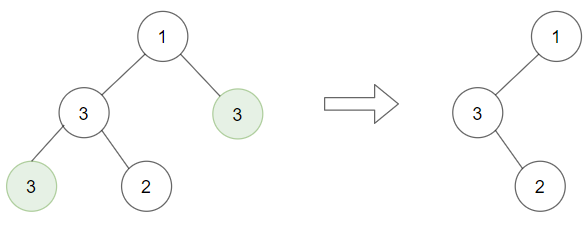二叉树 树 深度优先搜索
题目描述 给你一棵以 root 为根的二叉树和一个整数 target ,请你删除所有值为 target 的 叶子节点 。
注意,一旦删除值为 target 的叶子节点,它的父节点就可能变成叶子节点;如果新叶子节点的值恰好也是 target ,那么这个节点也应该被删除。
也就是说,你需要重复此过程直到不能继续删除。
示例 1:
输入: root = [1,2,3,2,null,2,4], target = 2
输出: [1,null,3,null,4]
解释:
上面左边的图中,绿色节点为叶子节点,且它们的值与 target 相同(同为 2 ),它们会被删除,得到中间的图。
有一个新的节点变成了叶子节点且它的值与 target 相同,所以将再次进行删除,从而得到最右边的图。
示例 2:
输入: root = [1,3,3,3,2], target = 3
输出: [1,3,null,null,2]
示例 3:
输入: root = [1,2,null,2,null,2], target = 2
输出: [1]
解释: 每一步都删除一个绿色的叶子节点(值为 2)。
提示:
树中节点数量的范围是 [1, 3000]。 1 <= Node.val, target <= 1000 解法 方法一:递归 我们先判断 \(root\) 节点是否为空,若为空,则返回空。
否则,递归地处理 \(root\) 的左右子树,即调用 root.left = removeLeafNodes(root.left, target) 和 root.right = removeLeafNodes(root.right, target)。
然后判断 \(root\) 节点是否为叶子节点,即判断 \(root.left\) 和 \(root.right\) 是否为空,且 \(root.val\) 是否等于 \(target\) 。若是,则返回空,否则返回 \(root\) 。
时间复杂度 \(O(n)\) ,空间复杂度 \(O(n)\) 。其中 \(n\) 为二叉树的节点个数。
Python3 Java C++ Go TypeScript
1
2
3
4
5
6
7
8
9
10
11
12
13
14
15
16
17 # Definition for a binary tree node.
# class TreeNode:
# def __init__(self, val=0, left=None, right=None):
# self.val = val
# self.left = left
# self.right = right
class Solution :
def removeLeafNodes (
self , root : Optional [ TreeNode ], target : int
) -> Optional [ TreeNode ]:
if root is None :
return None
root . left = self . removeLeafNodes ( root . left , target )
root . right = self . removeLeafNodes ( root . right , target )
if root . left is None and root . right is None and root . val == target :
return None
return root
1
2
3
4
5
6
7
8
9
10
11
12
13
14
15
16
17
18
19
20
21
22
23
24
25
26
27
28 /**
* Definition for a binary tree node.
* public class TreeNode {
* int val;
* TreeNode left;
* TreeNode right;
* TreeNode() {}
* TreeNode(int val) { this.val = val; }
* TreeNode(int val, TreeNode left, TreeNode right) {
* this.val = val;
* this.left = left;
* this.right = right;
* }
* }
*/
class Solution {
public TreeNode removeLeafNodes ( TreeNode root , int target ) {
if ( root == null ) {
return null ;
}
root . left = removeLeafNodes ( root . left , target );
root . right = removeLeafNodes ( root . right , target );
if ( root . left == null && root . right == null && root . val == target ) {
return null ;
}
return root ;
}
}
1
2
3
4
5
6
7
8
9
10
11
12
13
14
15
16
17
18
19
20
21
22
23
24
25 /**
* Definition for a binary tree node.
* struct TreeNode {
* int val;
* TreeNode *left;
* TreeNode *right;
* TreeNode() : val(0), left(nullptr), right(nullptr) {}
* TreeNode(int x) : val(x), left(nullptr), right(nullptr) {}
* TreeNode(int x, TreeNode *left, TreeNode *right) : val(x), left(left), right(right) {}
* };
*/
class Solution {
public :
TreeNode * removeLeafNodes ( TreeNode * root , int target ) {
if ( ! root ) {
return nullptr ;
}
root -> left = removeLeafNodes ( root -> left , target );
root -> right = removeLeafNodes ( root -> right , target );
if ( ! root -> left && ! root -> right && root -> val == target ) {
return nullptr ;
}
return root ;
}
};
1
2
3
4
5
6
7
8
9
10
11
12
13
14
15
16
17
18
19 /**
* Definition for a binary tree node.
* type TreeNode struct {
* Val int
* Left *TreeNode
* Right *TreeNode
* }
*/
func removeLeafNodes ( root * TreeNode , target int ) * TreeNode {
if root == nil {
return nil
}
root . Left = removeLeafNodes ( root . Left , target )
root . Right = removeLeafNodes ( root . Right , target )
if root . Left == nil && root . Right == nil && root . Val == target {
return nil
}
return root
}
1
2
3
4
5
6
7
8
9
10
11
12
13
14
15
16
17
18
19
20
21
22
23
24
25 /**
* Definition for a binary tree node.
* class TreeNode {
* val: number
* left: TreeNode | null
* right: TreeNode | null
* constructor(val?: number, left?: TreeNode | null, right?: TreeNode | null) {
* this.val = (val===undefined ? 0 : val)
* this.left = (left===undefined ? null : left)
* this.right = (right===undefined ? null : right)
* }
* }
*/
function removeLeafNodes ( root : TreeNode | null , target : number ) : TreeNode | null {
if ( ! root ) {
return null ;
}
root . left = removeLeafNodes ( root . left , target );
root . right = removeLeafNodes ( root . right , target );
if ( ! root . left && ! root . right && root . val == target ) {
return null ;
}
return root ;
}
GitHub 




